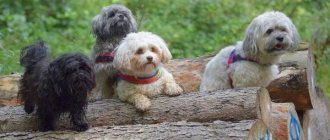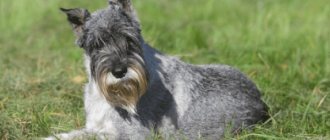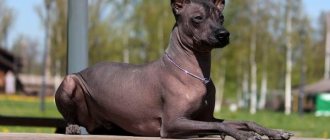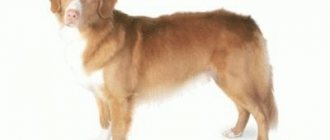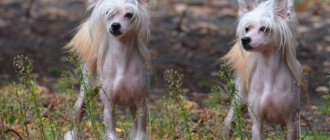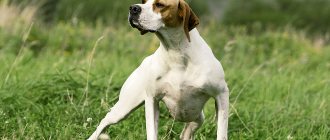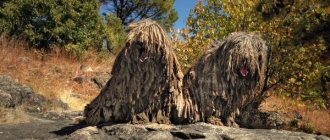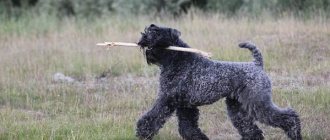There is no reliable information on the history of the breeding of this dog breed. There are several types of lap dogs, differing in appearance and character traits. The origin of each type of breed has its own version. The first information about small dogs, described as reminiscent of lapdogs, comes from the beginning of our era and is described in documents on the island of Melita (Maltese lapdog). There was a trading port on the island, which was visited by traders from many countries and exchanged their goods, including dogs. This is how lap dogs appeared in China.
During the Middle Ages, four-legged animals ceased to be just “small dogs”; the breed received a name. It comes from the Italian city of Bologna. This breed was in great demand in the aristocratic houses of Europe. Rich women owned them, keeping these animals as decorative ornaments. Breeders specifically focused on breeding lap dogs, trying to please the royal court and noble families. The common man was not interested in purchasing and maintaining such dogs. First of all, they required endurance and ability to work from the animal.
Nowadays, lapdogs are pets in many countries and are in great demand.
Breed standard
Each type of breed has soybean characteristics. The standard for all representatives, regardless of the species, is a small size, soft coat of light color: ivory, light orange, boiling white (the only exception in color is the Russian colored lapdog), a round head with a square muzzle, on which deep-set shiny dark eyes and a blue-black nose. The frontal lobe is clearly defined on the large, flat-shaped skull. The neck has no folds. The ears are triangular in shape, pressed tightly to the head and set close together. The forelimbs have much less developed muscles than the forelimbs. The height of the dog rarely exceeds 30 cm and weight no more than 5 kg.
Height – 30 cm
Weight – 4 kg
English cocker
The breed originated with Norfolks, ancient dogs with hunting abilities. It was from them that two different branches of Spaniels came - heavy Springers and medium-sized (up to 41 cm at the withers) Cockers. They hunt birds.
Most likely, the standard appearance of the Spaniel, which everyone knows, refers precisely to the English Cockers: these are small stocky dogs with a wide loin, a long body, a wedge-shaped muzzle, large drooping ears, and wavy hair. Animals have a good sense of smell thanks to their large sensitive nose and good eyesight. The breed is subject to strict standards. Which you can find in a detailed article about the English Cocker.
Dogs are family men, they love people, they treat children well, but they are wary of strangers and rarely get along with cats and small animals. Pets are sensitive to the mood of the owner and the atmosphere in the house. They need a loving family with an active lifestyle. The average cost is 10,000-20,000 rubles.
Bolonka - character
The lapdog is a very touching creature, incredibly charming, which will melt the heart of even the most callous person. She has a kind and cheerful character. He is distinguished by touchiness and vulnerability, needs love and constant attention from all household members. He is a children's best friend and will never cause harm under any circumstances. Living in a large family, these little four-legged animals give vibes of joy to every family member every second.
We advise you to read: Dog Breed Miniature Pinscher
Moscow watchdog
From the name of the breed it is clear that it was introduced for the purpose of protecting the territory. She has well-developed powers of observation and a territorial sense. The Moscow Watchdog has a massive body (weight - 40-50 kg), tall stature and thick fur. Outwardly, it resembles a hybrid of a St. Bernard and a Caucasian Shepherd Dog.
The priority task for this dog is to protect the territory where the owner and his family live. The dog is suspicious of people who come to see it, but is not aggressive, but only on condition that the owner himself let them in. No one without his permission will dare to set foot on the land guarded by the Moscow watchdog; she will not allow it.
This is a very noisy dog that can bark at anyone who comes close to its territory. So, she is trying to communicate her watchdog intentions. Despite the willfulness of the breed, it is quite easy to train. But there is no need to teach the Moscow guard, because this is inherent in it by nature.
Types of lapdogs
Maltese
This species is the most popular not only among lapdogs, but also among all decorative dogs in general. The Maltese (or Maltese) dog is characterized by a long coat of white or ivory color. During the time of the Chinese emperors, they were considered "royal" dogs. The breed itself is unpretentious. Due to the length of the coat, it requires constant care, which can be easily done at home. With proper care, it practically does not shed. The dog has an obedient and good-natured disposition.
French
The peculiarity of this breed is its curly white coat, which grows throughout the animal’s life. Therefore, it requires special careful care. Individuals participating in exhibitions need systematic visits to grooming salons and professional care throughout their lives. Another distinctive feature is the black expressive eyes, revealing the curiosity of the owner.
The historical roots of this type of lapdog go deep into the past. Despite the passage of centuries, the modern appearance is little different from its ancestors.
Havanese (Havanese)
The breed is relatively young, bred in Cuba. It is quickly gaining popularity around the world. The Havanese is a glamorous breed, sought after by wealthy people. Due to the need to live in comfortable conditions, inherent at the genetic level, it is not suitable for the average person or for people who do not have the opportunity to devote sufficient time to proper care and high-quality nutrition.
The appearance of a pet, just looking at it, evokes an irresistible desire to stroke its soft fur, pick it up and enjoy the sight of its charming face.
The Havanese dwarf dog is very good-natured, easily gets along with people and other inhabitants living in the house and meeting on the street while walking. They are absolutely alien to aggression and irritability. They need protection from the unfriendliness of other animals and people.
Russian Tsvetnaya lap dog
A distinctive feature of this species is its unusual coat color. Unlike the white color of other species, it has all shades of beige, gray and brown. The smallest white spot is classified as a defect. The breed was bred in Leningrad and for a long time was not officially recognized due to the admixture of poodles and Shih Tzu. It was recognized only in the 60s of the last century. Another unusual trait for lap dogs is the guard instinct. The dwarf dog rushes at anyone if it feels a threat to its owner. In everyday life she is quite friendly, flexible and compliant.
The disadvantage of the breed is that it does not get along well with very young children and is intolerant of loneliness. The dog should not be left alone for a long time; it may become depressed, melancholy or angry. Constant company needed.
Italian (bolognese)
Purebred representatives of this breed have a snow-white color that does not allow any spots. These are true aristocrats with a wayward temperament. Outwardly proud, they constantly require attention and increased care. Back in the twelfth century, these mini-dogs were in great demand in the homes of Italian aristocrats and were decorations for rich ladies and were presented as gifts.
We advise you to read: Scottish Terrier Dog Breed
Externally, Italian lapdogs, due to their fluffy fur that hides their graceful body, resemble a round soft lump.
Bologneses are very susceptible to injury due to their small size. For this reason, it is not recommended for families with small children. The breed has good health and, with proper care and maintenance conditions, has a long life expectancy, from 14 to 18 years.
Origin story
The lapdog breed could only arise in an era of prosperity and luxury: lapdogs are not capable of hunting, fighting, or guarding. These dogs are of little use. However, images of dogs very similar to lap dogs have been found in ancient Egyptian sources.
While depicting lapdogs, the predecessors of modern breeders did not bother to leave records on the breeding of indoor dogs. No wonder: who could be interested in a useless dog that pleases the eyes of representatives of the highest nobility?
They tried to attach the lapdog to the business. Repeatedly they were assigned to hunt rodents - on ships, in palaces. But the result was not impressive. Each time there were breeds that were more successful in this field.
In the Middle Ages, European aristocrats gladly inhabited castles and palaces with playful, cheerful lap dogs - a kind of indicator of wealth and luxury, indicating the refined taste of the owner or owner.
The name of the breed itself comes from the Italian city of Bologna, although, with the same success, lap dogs could be named after any other European city - the European aristocracy was surprisingly unanimous in their enthusiasm for buying dogs of this breed.
For centuries, breeders have tried to make the appearance of the representatives of the breed as touching as possible, and their character as playful and loving. Judging by the number of varieties of lapdogs and their continued popularity throughout the world, this problem has been completely solved.
Many world-famous stars have kept or are keeping lap dogs as permanent companions. You can mention Patricia Kaas, Elvis Presley, Elizabeth Taylor, Cindy Crawford and even Barack Obama . Among domestic famous people, the lapdog was seen in Alla Pugacheva .
Maintenance and care of a lapdog
If the owner does not intend to exhibit dogs at exhibitions and does not plan to participate in competitions, the lapdog does not require much effort and does not cause difficulties in caring for it. It is recommended to comb your pet daily, without using a slicker brush, so as not to damage the delicate skin by picking out tangles manually. To make caring for the dog's coat easier, you can cut your dog's hair. Due to the slow growth of fur, care will be greatly simplified. The area around the anus should be cut regularly, and the bangs should be tied with an elastic band so that they do not get into the eyes. To ensure that the haircut follows all the rules, provide the care of your pet to a highly qualified specialist, a dog groomer. Bathing procedures are carried out once a week using special shampoos and conditioners, but the limbs are washed after each walk, which is carried out twice a day for at least two hours.
In the cold season, lap dogs need to be walked in clothes. After bathing your pet, pat dry with a soft towel and dry with a hairdryer. Eyes and ears require care as they become dirty, but at least once every three days. Brushing your teeth is recommended every other day using a soft toothbrush. Nail trimming is carried out as needed. It is recommended to have up-to-date vaccinations appropriate for the dog's age. The muzzle is washed after every meal. Your pet's diet must include beef or chicken, cereals, eggs, fermented milk products, boneless fish, vegetables and fruits. If the owner is not able to calculate the required balance, it is better to buy ready-made dry food or alternate.
Do not overfeed this breed of dog, they are prone to obesity. Regarding nutrition, consult the breeder from whom you purchased your four-legged friend.
Like any other breed, lapdogs need proper training. Training should begin no earlier than the puppy is two months old. Provide your baby with squeaky toys. Even at puppyhood, your pet needs to be taught what is and is not allowed. Do not punish under any circumstances, but reward for every correctly executed command. The dog must accept the owner’s orders the first time and carry them out instantly. One of the first commands that you need to teach your pet is “Come to me!” in order to avoid the threat of danger during walks. Small dogs do not understand the difference between sizes and can be injured by larger animals.
Don't follow your pet's lead and avoid excessive pampering. Otherwise, he will not accept prohibitions and the “no” command. If possible, take your pet to a professional trainer, first of all, in order to learn how to communicate with your four-legged friend.
We advise you to read: Chow Chow Dog Breed
Get your vaccinations up to date and take them to the vet for check-ups.
English Mastiff
There is still some debate as to what the largest dog breed is. Some believe that it should be one of the representatives of the “wolfhounds”, but the majority still believe that it is an English mastiff.
This is a large animal, weighing more than 80 kg. Height – 75 cm. His physique is slender. The animal stands out with its massive head, which harmonizes well with other parts of the body. The color of the short coat is light apricot, but the muzzle has a dark “mask”. The mastiff's paws are slightly sloping, as are his shoulders. The chest is wide, and the tail is long and thick.
Unfortunately, such exterior features lead to frequent diseases, for example, elbow dysplasia. The English Mastiff also often suffers from leukemia, pyoderma and glaucoma. This dog is not only a loyal friend, but also an excellent guard. She quickly becomes attached to her owner and devotes her life to serving him.
Approximate price of a puppy
City residents are increasingly giving preference to mini-dogs. Decorative pets do not require large spaces; they emit fewer specific aromas. One of the most popular breeds is the lapdog.
The price of puppies depends on the pedigree, variety and for what purpose it is purchased. If the owner does not plan to participate in exhibitions and competitions, but gets a pet for simple keeping in the family, you can choose a baby from rejected puppies, for example, one that is absolutely healthy, but has a defect in color. The price of substandard copies will be a maximum of 15-18 thousand. Offspring with a pedigree and a full package of documents costs an order of magnitude more, reaching 120,000 rubles. The cheapest are Russian Tsvetnaya lapdog babies, since this species is recognized only by cynologists in the Russian Federation and is not suitable for exhibitions.
Taking care of your health
The main characteristics of the breed also include a strong immune system and resistance to various infections and viruses. Animals are also immune to 99% of all hereditary and genetic pathologies. All pets are susceptible to various diseases, like others, but, firstly, thanks to a strong immune system, they are quickly cured, and secondly, the incidence of illness is quite low.
But it is important to remember that dogs are susceptible to such deadly viral diseases as plague and rabies. Therefore, the animal should be vaccinated in a timely manner and undergo annual revaccination.
Lifespan
On average, colored lapdogs live from 12 to 16 years.
Nurseries
When choosing a pet, it is not recommended to trust unverified sources. You should contact dog breeding kennels or reputable kennel clubs. By purchasing a dog in specialized places, the buyer is guaranteed to protect himself from purchasing a mixed breed, genetically diseased offspring, or a litter from an emaciated, sick female. When selling titled puppies, the breeder is required to provide a veterinary passport, the mark of the Russian Canine Federation, and a record of age-appropriate vaccinations. To be more confident, you should contact an independent expert. It is allowed to separate the puppy from its mother after two months. The breeding of lapdogs is practiced in almost all major cities. A list of nurseries and breeders, addresses, photographs and reviews can be found on the Internet.
Magyar agar
Also known as the Hungarian Greyhound. The first mention of the breed dates back to the 10th century, when dogs of this species were kept by members of the nobility to chase deer and hares during horse hunts. These are timid, reserved dogs, hardy, capable of long runs.
The height at the withers of females is 61-67 cm, males – 65-70 cm. The dog’s body is noticeably elongated in length, the bones and muscles are highly developed and clearly visible. The head of the Magyar-agar is wedge-shaped, not sharp, and quite voluminous. The ears are large, heavy, pressed to the neck, but can be raised. The coat is short, single-layered, and comes in almost any color except blue, brown, wolf, tan and tricolor.
Photos of Bolonka
Beagle
"Beagle"
Beagle dogs originated in medieval England. The royal nobility used them to track deer and roe deer and hunt hares. This breed of small dogs instantly captivates with its remarkable charm, and their charming eyes seem to look straight into your soul, especially if the animal has set the goal of begging you for a treat. These dogs have a short and dense coat, standard height at the withers varies between 33-40 cm and a weight of 9-14 kg. Beagles have an excellent temperament - they are energetic and intelligent, playful, loyal and friendly. Their keen sense of smell can sometimes make walks especially interesting as they try to keep track of every scent they encounter.
Mating
Official mating must take place under the patronage of a nursery . To do this, dog owners sign and fill out a special form indicating the date. Both pets are checked and disinfected. The owner of the dog sets the price. Usually it is equal to one puppy or a percentage of the cost of the dog. If the female does not become pregnant, mating is not paid.
Bolonki become sexually mature at 10 months, but the most favorable period for mating is 2 years. During heat, the girl should show some signs indicating readiness: loosening and softening of the loop, clear discharge and playful behavior.
The female is brought to the male dog’s territory so that the boy feels confident and knows that this act is carried out only in his home . The animals sniff and get to know each other. After which the girl will allow you to do the cage. If there is no lock, there is no need to worry, this does not mean that the female is empty. Repeated fastening is carried out after 48 hours.
Coton de Tulear
The second name of the breed is Madagascar Bichon. The Bolonki Islands arrived from France in the 17th century. There is a legend that after a shipwreck near the port of Tulear, several dogs survived and bravely swam across the rest of the strait and ended up on the island, where they mixed with aboriginal mongrels. This is how the unyielding, brave, fearless Bichons turned out - Coton do Tulear (the first part of the name is translated as “cotton” from French).
The Africans found the dogs, tamed them, washed them and sent them to the sea - on ships to serve as rat catchers. This is how the Tulears, called “kings of Africa,” would have sailed if the pampered Europeans had not noticed them and taken them to their palaces.
Like all Bolonki, Cotons are small (up to 28 cm at the withers), stocky, dense, but graceful and graceful, with long ears, a high tail and a royal posture. Their distinctive feature is long gray or ashy spots among the curls of flowing, wavy white coat. Due to their short, thick limbs, Tulears have to jump with four legs rather than two.
Animals will follow their master into fire and water. They are ideal companions with good physical fitness, hardy, courageous and cheerful. Dogs know how to adapt to their owner: they are ready to entertain children, relax with an elderly person, go for a run in the morning or lie on the couch all day.
Possible diseases
In general, the dog is in good health. The first months of an animal’s life are considered the most dangerous period, since you need to monitor your Maltese puppy . First, get your blood sugar levels under control. If you lose sight of this, then as the dog matures, the tracheal cartilage will become weaker, which will lead to problems in the respiratory system.
Because of this, it will not be possible to wear a collar. In addition, you need to make sure that no one steps on or squeezes the new little resident of the apartment or house. Because they are very fragile in childhood. The most common health problems for this dog are:
- Dental.
- Dislocation of the knee joint and cap.
- Glaucoma and retinal atrophy.
- Predisposition to liver diseases.
- Blocked tear ducts.
Another interesting feature of the Maltese is the uncontrollable trembling of the whole body. Because of this problem, the dog practically stops moving normally. Veterinarians are trying to treat this disease with medication.
